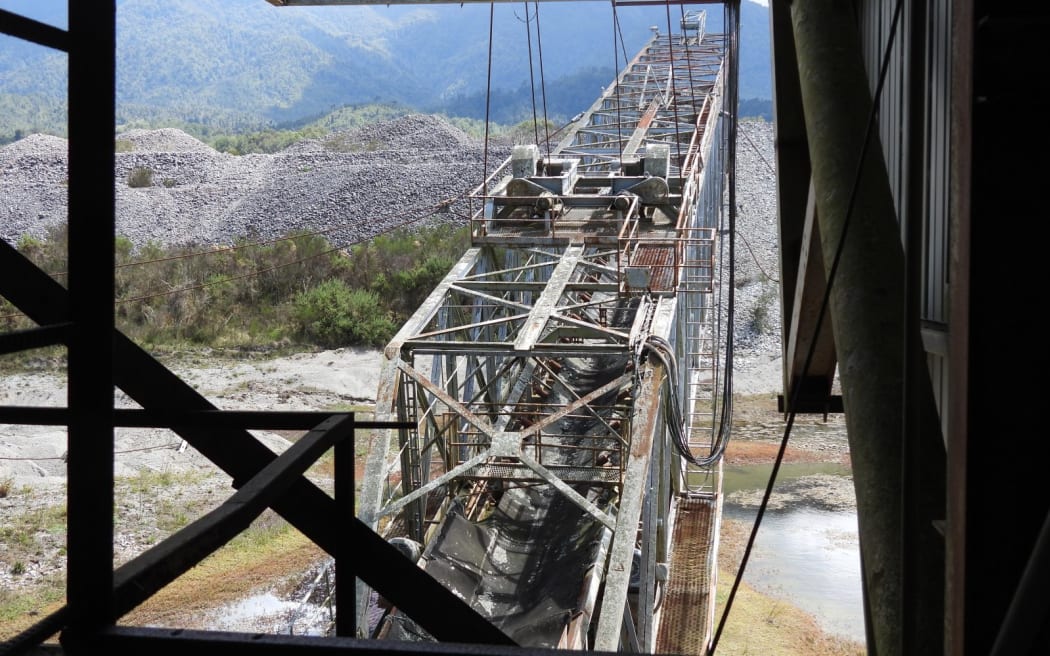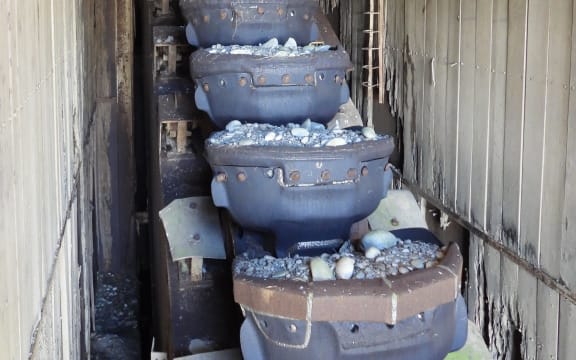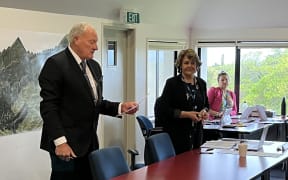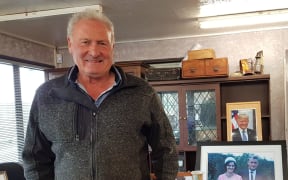
The 'bow' of the dredge complete with the improvised gangway to land, made out of flat-deck railway wagons joined together. Photo: Greymouth Star / Brendon McMahon
The Grey Valley gold dredge sits like a giant bulwark in the Grey River. For more than 30 years it has floated amidst a riverscape dominated by the moody Paparoa Range to the west, and between the villages of Blackball and Ngahere on opposite sides of the river.
Since about 2013 the dredge has been idle, but its mere presence has caused a bit of a flap lately - and will potentially be the downfall of West Coast Regional Council chairman Allan Birchfield.
Local Democracy Reporter Brendon McMahon got a tour of the mothballed dredge with Birchfield - before his own councillors signed a requisition to remove him as chairman.
The dredge and the entanglement of its owner and West Coast Regional Council helmsman Allan Birchfield, through a deal brokered by the council's business arm VCS eight years ago, has unmoored him. And it is certainly something he now regrets.
Birchfield is the longest current-serving local body politician on the West Coast, into his seventh term on the regional council - and for now, his second term as chairman.

He was again nominated for the chair following the 2022 local body elections, but he has been on leave since December as the dredge financial storm was whipped up again amidst other murky happenings around his tenure at the council.
Back in 2015, the council-owned VCS approached Birchfield suggesting they take on the dredge project, gain the consent renewals and then sell the dredge on his behalf. The debt would remain on the council books and not have to be repaid until the dredge was sold. It seemed like a good idea at the time - but the dredge has not sold, and the debt remains.
With an internal row brewing among councillors in December, he admitted it was not such a good idea at all.
Shortly before going on leave Birchfield stood by the VCS deal, but he told the Greymouth Star in hindsight he would not have done it again.
"To be honest, I was talked into this deal... that it would be a great thing for the district. I was finished with it. I said, 'Okay, if you want to have a go, go for it'. I was basically over it," Birchfield said at the time.
For eight years the $157,025 cost against the VCS ledger due to the agreement has remained on the balance sheet like an uncomfortable boil - raising the spectre of conflict of interest.
'It's not always about money'
On a stifling late summer's day when the Greymouth Star visited the mothballed dredge in question, there was barely the ruffle of a flapping pigeon wing in the air nor a ripple on the deep clear pond where the monolith quietly floats beside the Grey River bed.
On that day a refreshed looking Birchfield says the regional council is off the agenda - for now - but he does express some hope the dredge will somehow spring back to life.
"It's not always about money: it's about mining and having machinery working - if you are into that," he says quietly of the dredge that has occupied his thoughts for more than 30 years.
The colour of dreams - gold and hope - focused a community around the dredge when it employed upwards of 100 people in the Grey Valley.
From 1989 the dredge managed to delve deeper than any old-time goldminer could have dared to dream, as it meandered and chewed its way through 300ha of riverbed.

Allan Birchfield. Photo: Greymouth Star / Brendon McMahon
About 140 years ago, gold digging in the Grey Valley was about the easy pickings on the accessible terraces and tributary streams bordering the river. Blackball, Moonlight and Nelson Creek all had their time but their boom was relatively brief as the hard won efforts of pan, cradle and sluice eventually petered out.
It was the emergence of big dredge technology in the early to mid-20th century that coalesced real action on the Grey River goldfield. The dredges finally allowed miners to plumb the riverbed down to 20 or 30m where the precious gold really was.
"It's only a dredge of that size that can get down that deep," Birchfield explains.
Construction of the Grey Valley dredge began about 1980. Initially owned by American company R A Hanson, after "fits and starts" the massive steel beam structure atop a barge at least 100m long finally rattled into life in 1989.
The initial operation was fairly brief before Birchfield Minerals bought it in 1992.
"We've been here 30 years," Birchfield says.
While the dredge was a completely new build at the time, it incorporated many elements of the core of the famous West Coast dredge of the 1940s to the 1970s, the Kaniere, along with parts from the Arahura dredge.
"She's been around, started at Kaniere, went to Kumara, and now has been to Blackball and back," he notes.
"We've done over 300ha since Birchfields bought it in 1992."
Birchfields operated it till 2004, and then again from 2007 to 2012 before he simply ran out of energy and it was mothballed.
The rest is history - including the approach by the regional council's business unit around 2015 to help gain new consents and market it for sale.
Birchfield says VCS is no longer involved and he now fields the calls from potential buyers.
The field of interest includes scrap metal merchants, and he admits that in the end he might have to let it go that way.
But the plan is, he says, to get it operational again within the next year so that it can be properly demonstrated in order that someone else might take it on and provide viable employment on the West Coast.
Lately, a big clean-up has been under way, including clearing the detritus left by birds.
"The whole dredge is getting a tidy-up, removing any surplus machinery and the next stage is getting it operational again... It will be moved about half a kilometre east towards Ngahere by the end of the year."
Birchfield proudly notes his dredge is now a unique vessel for New Zealand.
It is a 'she' in the tradition of water-borne vessels, and stands testament to the kind of ingenuity behind the legendary classic West Coaster, honing a living in a hard won fight among the natural elements.
"Something like this would normally be built in a shipyard. To be built in the open at Ngahere, you can imagine it would be a bit of a task.
"Wind does cause issues for us because we are a big sail area, as you can imagine."
Wind causing damage to the iron cladding has made life interesting, "plus we got struck by lightning a few times because we're such a big steel structure".
The other threats are floods and, he wryly notes, "bureaucrats".
"They were the worst. The other things we can handle."
The all-electric but mechanical dredge has its quirks with its own 11,000v connection to the national grid.
That powers a couple of General Electric DC (direct current) 1000hp electric locomotive units to propel its intricate internal workings.
Birchfield says the DC the set up allows the dredge to be 'dialled up' at full power from zero to get the whole operation slowly moving to protect its moving parts in "a slow start up".
"That's the beauty of the DC."
Everything on this dredge is big, from the huge gold recovery tables to the 15m-long rotating gold screen. Each of several levels to the floating structure is connected by narrow gangways and steps - something which would keep anyone fit after an hour trailing Birchfield up and down steps. The heights are giddying, aside from anything else.

The ascending bucket line. Photo: Greymouth Star / Brendon McMahon
The huge 105-piece bucket line to draw up gravel and gold ore from the depths of the riverbed is a sight to behold. And the amounts the dredge can process at full working-tilt are mind boggling: 40,000 litres of wash water pumping through the gold screen every minute, fed by 12 cubic metres of gravel every minute from the bucket line.
The biggest part of the dredge is the pontoon, probably weighing about 2000 tonnes.
"It's just a big barge really."
The working of the dredge was all about re-creating the natural processes of a river: the rolling current suspending gravity to separate the naturally heavier gold to the bottom and out via the gold tables, the precious metal being 19 times heavier than water.
For its age, the all-metal dredge is still in fairly good nick, sitting in pure Grey River water feeding its own dredge pond.
When it was operating, the dredge was a constant hive of activity and noise - a grind of metal parts, friction, and dust.
Birchfield says every aspect including the bucket line ascending from the depths below the barge and up through multiple levels required constant maintenance due to basic friction.
The bucket line alone required constant work to guard against the possibility of a major breakdown, let alone keeping on top of the chain stretch in the bucket line due to the massive weights it continuously pulled.
"It's a continual job reconditioning the bucket line, at least one a week - which would take a year to keep it up to spec. They wear around the top and bottom sprockets. Each bucket as it goes over the top, it's pulling 50 up behind - and full too!"
Keeping up with the dredge was a matter of constant vigilance.
"I would have spent over 1000 hours on this bucket deck. The biggest part was mending the bucket line: we couldn't afford to let one bucket get out of condition - otherwise it risked the whole line to fail. It's the old thing - the chain is only as good as it's weakest link."
Birchfield points out the massive crane winches built into the dredge at different levels - five of them - a vital aspect of it given the huge individual parts that needed to be pushed and pulled on a daily basis.
"You can't do much by hand here: you have to use a crane. It was pretty well designed."
When the dredge came into Birchfield's hands it was semi-computerised but this always proved problematic.
"Birchfields made it more manual than how it had been rebuilt."
Business ebbs and flows
After a few years of dredging it was mothballed in 2004 as unprofitable, restarting in 2009 with a $2.2 million loan from Development West Coast.
It ran until 2012, when falling gold prices and resource consents led to it being mothballed again.
The following year Birchfield successfully defended eight charges brought by the Department of Conservation of undertaking commercial gold mining without authority and damaging conservation land at Blackball and the Grey River.
When he turned 65 in 2016, Allan Birchfield announced his retirement from gold mining. But after eight years, nothing has changed. He's still there, still working every day on his other land-based goldmine near Kumara and the dredge is still for sale.
But whether he can survive the coup within his own council ranks will be seen on 28 March.
Local Democracy Reporting is Public Interest Journalism funded through NZ On Air.



